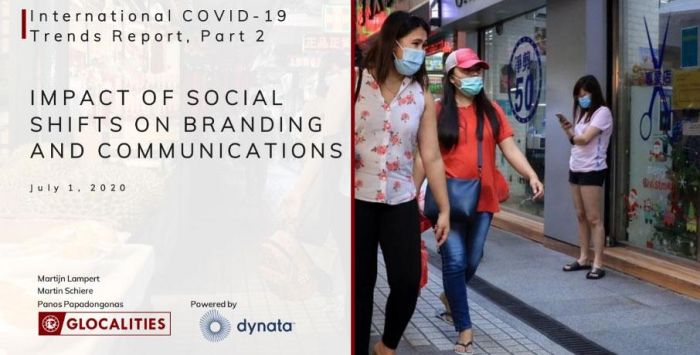International COVID-19 Trends Report, Part 2
IMPACT OF SOCIAL SHIFTS
ON BRANDING AND COMMUNICATIONS

Our international COVID Trend survey report, in cooperation with Dynata that was released on June 11, called "Shrinking World", identified five main trends. This new report shows that different consumer groups or target audiences react differently to these trends, sometimes even in opposite directions. As such, it is imperative for marketers to look not only at the trends themselves but also at how they affect different target audiences. And last but certainly not least, it is vital to evaluate what these effects might imply for your branding and communication to these audiences. Just because your target audience is affected does not necessarily mean that your brand positioning or communication should change.
FIVE IDENTIFIED TRENDS
The five trends, described in more detail in our latest COVID trends report are:
1. Back to Basics - In general, consumers have become more inward-looking and want to serve their basic needs first before indulging. They have also become more risk-averse and are hesitant to make long-term plans due to the uncertainties that come with a crisis.
2. Small world - On average people are less open to the globalized world at large and towards people with other philosophies of life. The level of trust in the distant "other" has gone down. For instance, trust in international organizations and multinationals has decreased. This can have significant implications for international brands that focus on their cosmopolitan or international heritage.
3. Truthfulness - (in science and education) has made a come-back. In their quest for more security and information they can trust, consumers demand truthfulness in communications from governments and brands alike. This also implies that consumers are becoming more critical about how brands communicate.
4. Here and now - In the eye of the storm of a crisis, people are on high alert and increasingly live in the moment. People dream and fantasize less. For some consumer groups, this also means fewer long-term goals and more instant gratification. It is no coincidence that more people currently agree with the view that buying something new is one of the joyful things in life.
5. Community spirit has increased - Consumers feel more involved with the community they live in and increasingly aspire to work for an organization that also pursues social goals. Purpose and contributing to society are becoming increasingly important for brands. Consumers also have a greater interest in politics, as political decisions are having an immediate effect on their daily reality and prospects.
TARGET AUDIENCES REACT IN DIFFERENT WAYS TO THE COVID TRENDS
Distinct Consumer Groups Behave Differently
The way that the current crisis shapes consumers’ attitudes and world view depends on the extent to which consumers crave control and belonging, or the freedom to explore and experiment. To exemplify and quantify how these factors shape attitudes towards the crisis and the future, we use our five distinct Glocalities consumer group segments: Challengers, Conservatives, Socializers, Creatives, and Achievers.
Conservatives and Socializers feel that their world is being threatened by the coronavirus and are most willing to accept strict measures in exchange for security.
Explorative Target Audiences Most Affected
Creatives and Challengers are the most exploration oriented consumer groups and are experiencing the most pressure during the current crisis, albeit in different ways. Challengers want their freedom back to realize their own ambitions, whereas Creatives call for a more open world that addresses the needs of the most vulnerable people, wherever they may live. Achievers are a consumer segment that is ambitious and outward-looking on the one hand, but also embrace the need to protect their own community on the other hand. Companies and brands that target the rebellious Challengers or the idealistic Creatives should re-assess their communication strategy and content because of how their consumers are affected.
DANGER OF OVERREACTING AS BIG AS NOT REACTING
The Danger Of Over-Reacting Or Reacting In The Wrong Manner
As mentioned in our previous COVID trend report, some attitudes and socio-cultural trends have changed, but numerous aspects of human attitudes and behavior have not. Without proper insights into the effect of the crisis on target audiences, one can easily live under the impression that everything is changing and that brands should radically adapt their communication to a “new normal." This can lead to over-reaction and shifts in brand positioning and communication that are not in-line with the target audience. A good example of this is Gucci.
Gucci's Overdoing It
In reaction to the current coronavirus crisis and other global events, Gucci’s acclaimed creative director Alessandro Michelle came up with a new “Conscious Living" creative approach. Furthermore, in a bold move, Gucci just launched its first sustainable line. In a similar vein, actress Emma Watson, a well-known supporter of eco-friendly fashion, just joined the board of Gucci owner, Kering.
Although environmental sustainability is always an appealing concept to employ in positioning and numerous brands use social and environmental causes to connect with their consumers, our analysis of the Gucci consumer suggests that such a radical turn towards sustainability is not in line with the current Gucci consumers.
Gucci is a typical brand appealing to Challengers and Achievers. Gucci customers like to stand out, and they are eager to adopt new concepts and products. At the same time, they are very ambitious and want to enjoy life as well. However, Gucci consumers tend to care less about environmental sustainability.
In a shrinking world, Gucci customers are among the first consumers who experience that their freedom to realize their potential is being threatened. However, Gucci's consumers’ fundamental values and attitudes to life have been impacted to a smaller extent.
Gucci's current "Conscious Living" and sustainability approach risks alienating its existing customer base while not yet being credible and rooted enough to attract more Creative-oriented target audiences.
Based on the Glocalities data, we believe that Gucci needs to incorporate more adventure, enjoyment, and cosmopolitan culture into its campaign. An option would be to expand its cooperation with rapper Lil Nas further and include more black and Asian edgy artists, both on the design and communications front.
Download the Shrinking World report (part 1 out of 3) here.




